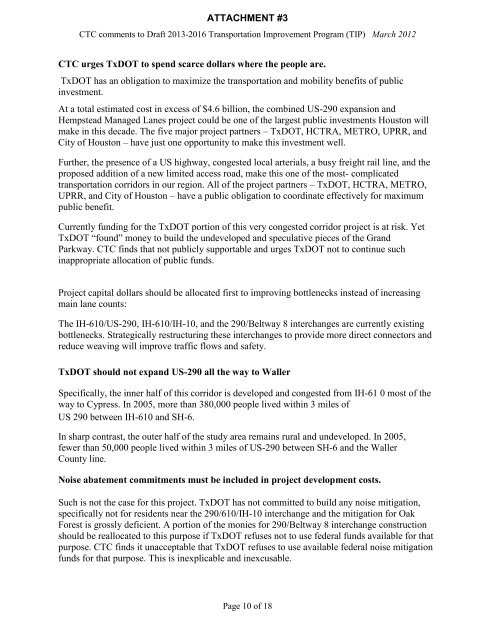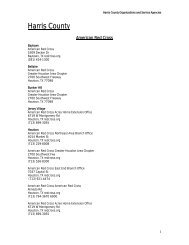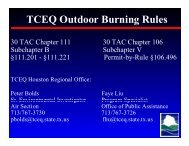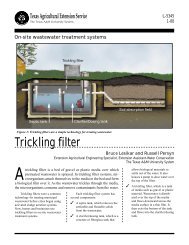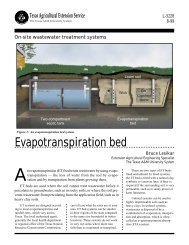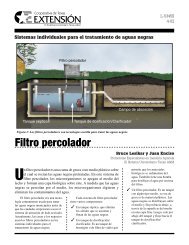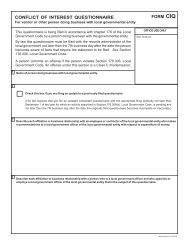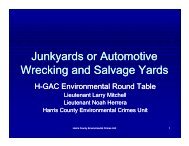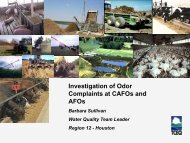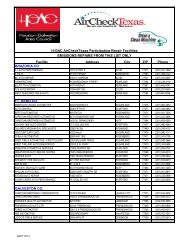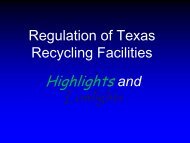- Page 1 and 2:
The 2013-2016 Transportation Improv
- Page 3 and 4:
This page left blank intentionally.
- Page 5 and 6:
Table of Contents iv Table E-1. Uni
- Page 7 and 8:
TPC Agenda Item 6 B Mailout - 04/20
- Page 9 and 10:
This page left blank intentionally.
- Page 11 and 12:
1-4 2013-2016 Transportation Improv
- Page 13 and 14:
1-6 2013-2016 Transportation Improv
- Page 15 and 16:
Chapter 2 Financial Plan
- Page 17 and 18:
Financial Plan Chapter 2 2-3 Chapte
- Page 19 and 20:
Financial Plan Chapter 2 2-5 Federa
- Page 21 and 22:
2013-2016 Transportation Improvemen
- Page 23 and 24:
2013-2016 Transportation Improvemen
- Page 25 and 26:
Highway Project Listing Chapter 3 3
- Page 27 and 28:
Highway Project Listing Chapter 3 3
- Page 29 and 30:
Friday, April 27, 2012 HOUSTON-GALV
- Page 31 and 32:
Friday, April 27, 2012 HOUSTON-GALV
- Page 33 and 34:
Friday, April 27, 2012 HOUSTON-GALV
- Page 35 and 36:
Friday, April 27, 2012 HOUSTON-GALV
- Page 37 and 38:
Friday, April 27, 2012 HOUSTON-GALV
- Page 39 and 40:
Friday, April 27, 2012 HOUSTON-GALV
- Page 41 and 42:
Friday, April 27, 2012 HOUSTON-GALV
- Page 43 and 44:
Friday, April 27, 2012 HOUSTON-GALV
- Page 45 and 46:
Friday, April 27, 2012 HOUSTON-GALV
- Page 47 and 48:
Friday, April 27, 2012 HOUSTON-GALV
- Page 49 and 50:
Friday, April 27, 2012 HOUSTON-GALV
- Page 51 and 52:
Friday, April 27, 2012 HOUSTON-GALV
- Page 53 and 54:
Friday, April 27, 2012 HOUSTON-GALV
- Page 55 and 56:
Friday, April 27, 2012 HOUSTON-GALV
- Page 57 and 58:
Friday, April 27, 2012 HOUSTON-GALV
- Page 59 and 60:
Friday, April 27, 2012 HOUSTON-GALV
- Page 61 and 62:
Friday, April 27, 2012 HOUSTON-GALV
- Page 63 and 64:
Friday, April 27, 2012 HOUSTON-GALV
- Page 65 and 66:
Friday, April 27, 2012 HOUSTON-GALV
- Page 67 and 68:
Friday, April 27, 2012 HOUSTON-GALV
- Page 69 and 70:
Friday, April 27, 2012 HOUSTON-GALV
- Page 71 and 72:
Friday, April 27, 2012 HOUSTON-GALV
- Page 73 and 74:
Friday, April 27, 2012 HOUSTON-GALV
- Page 75 and 76:
Friday, April 27, 2012 HOUSTON-GALV
- Page 77 and 78:
Friday, April 27, 2012 HOUSTON-GALV
- Page 79 and 80:
Friday, April 27, 2012 HOUSTON-GALV
- Page 81 and 82:
Friday, April 27, 2012 HOUSTON-GALV
- Page 83 and 84:
Friday, April 27, 2012 HOUSTON-GALV
- Page 85 and 86:
Friday, April 27, 2012 HOUSTON-GALV
- Page 87 and 88:
Friday, April 27, 2012 HOUSTON-GALV
- Page 89 and 90:
Friday, April 27, 2012 HOUSTON-GALV
- Page 91 and 92:
Friday, April 27, 2012 HOUSTON-GALV
- Page 93 and 94:
Friday, April 27, 2012 HOUSTON-GALV
- Page 95 and 96:
Friday, April 27, 2012 HOUSTON-GALV
- Page 97 and 98:
Friday, April 27, 2012 HOUSTON-GALV
- Page 99 and 100:
Friday, April 27, 2012 HOUSTON-GALV
- Page 101 and 102:
Friday, April 27, 2012 HOUSTON-GALV
- Page 103 and 104:
Friday, April 27, 2012 HOUSTON-GALV
- Page 105 and 106:
Friday, April 27, 2012 HOUSTON-GALV
- Page 107 and 108:
Friday, April 27, 2012 HOUSTON-GALV
- Page 109 and 110:
Friday, April 27, 2012 HOUSTON-GALV
- Page 111 and 112:
Friday, April 27, 2012 3-88 HOUSTON
- Page 113 and 114:
Transit Projects Chapter 4 4-2 This
- Page 115 and 116:
Public Transportation Projects Chap
- Page 117 and 118:
Public Transportation Projects Chap
- Page 119 and 120:
FY 2013 TRANSIT PROJECT DESCRIPTION
- Page 121 and 122:
FY 2013 TRANSIT PROJECT DESCRIPTION
- Page 123 and 124:
FY 2013 TRANSIT PROJECT DESCRIPTION
- Page 125 and 126:
FY 2013 TRANSIT PROJECT DESCRIPTION
- Page 127 and 128:
FY 2013 TRANSIT PROJECT DESCRIPTION
- Page 129 and 130:
FY 2013 TRANSIT PROJECT DESCRIPTION
- Page 131 and 132:
FY 2013 TRANSIT PROJECT DESCRIPTION
- Page 133 and 134:
FY 2013 TRANSIT PROJECT DESCRIPTION
- Page 135 and 136:
FY 2013 TRANSIT PROJECT DESCRIPTION
- Page 137 and 138:
FY 2013 TRANSIT PROJECT DESCRIPTION
- Page 139 and 140:
FY 2013 TRANSIT PROJECT DESCRIPTION
- Page 141 and 142:
FY 2014 TRANSIT PROJECT DESCRIPTION
- Page 143 and 144:
FY 2014 TRANSIT PROJECT DESCRIPTION
- Page 145 and 146: FY 2014 TRANSIT PROJECT DESCRIPTION
- Page 147 and 148: FY 2014 TRANSIT PROJECT DESCRIPTION
- Page 149 and 150: FY 2014 TRANSIT PROJECT DESCRIPTION
- Page 151 and 152: FY 2014 TRANSIT PROJECT DESCRIPTION
- Page 153 and 154: FY 2014 TRANSIT PROJECT DESCRIPTION
- Page 155 and 156: FY 2014 TRANSIT PROJECT DESCRIPTION
- Page 157 and 158: FY 2014 TRANSIT PROJECT DESCRIPTION
- Page 159 and 160: FY 2014 TRANSIT PROJECT DESCRIPTION
- Page 161 and 162: FY 2014 TRANSIT PROJECT DESCRIPTION
- Page 163 and 164: FY 2015 TRANSIT PROJECT DESCRIPTION
- Page 165 and 166: FY 2015 TRANSIT PROJECT DESCRIPTION
- Page 167 and 168: FY 2015 TRANSIT PROJECT DESCRIPTION
- Page 169 and 170: FY 2015 TRANSIT PROJECT DESCRIPTION
- Page 171 and 172: FY 2016 TRANSIT PROJECT DESCRIPTION
- Page 173 and 174: FY 2016 TRANSIT PROJECT DESCRIPTION
- Page 175 and 176: FY 2016 TRANSIT PROJECT DESCRIPTION
- Page 177 and 178: Appendix A Public Comments
- Page 179 and 180: Public Comments Appendix A A-3 Appe
- Page 181 and 182: ATTACHMENT #3 TC Agenda Item 6 Mail
- Page 183 and 184: ATTACHMENT #3 TC Agenda Item 6 Mail
- Page 185 and 186: ATTACHMENT #3
- Page 187 and 188: ATTACHMENT #3
- Page 189 and 190: ATTACHMENT #3 CTC comments to Draft
- Page 191 and 192: ATTACHMENT #3 CTC comments to Draft
- Page 193 and 194: ATTACHMENT #3 CTC comments to Draft
- Page 195: ATTACHMENT #3 CTC comments to Draft
- Page 199 and 200: ATTACHMENT #3 CTC comments to Draft
- Page 201 and 202: ATTACHMENT #3 CTC comments to Draft
- Page 203 and 204: ATTACHMENT #3 CTC comments to Draft
- Page 205 and 206: ATTACHMENT #3 CTC comments to Draft
- Page 207 and 208: ATTACHMENT #3
- Page 209 and 210: Appendix B Project Development
- Page 211 and 212: Project Development Appendix B B-3
- Page 213 and 214: Project Development Appendix B B-5
- Page 215 and 216: Appendix C Status of Major Projects
- Page 217 and 218: This page left blank intentionally.
- Page 219 and 220: This page left blank intentionally.
- Page 221 and 222: MPOID [CSJ] SPONSOR HOUSTON-GALVEST
- Page 223 and 224: MPOID [CSJ] SPONSOR HOUSTON-GALVEST
- Page 225 and 226: MPOID [CSJ] SPONSOR HOUSTON-GALVEST
- Page 227 and 228: MPOID [CSJ] SPONSOR HOUSTON-GALVEST
- Page 229 and 230: MPOID [CSJ] SPONSOR HOUSTON-GALVEST
- Page 231 and 232: MPOID [CSJ] SPONSOR HOUSTON-GALVEST
- Page 233 and 234: MPOID [CSJ] SPONSOR HOUSTON-GALVEST
- Page 235 and 236: MPOID [CSJ] SPONSOR HOUSTON-GALVEST
- Page 237 and 238: MPOID [CSJ] SPONSOR HOUSTON-GALVEST
- Page 239 and 240: MPOID [CSJ] SPONSOR HOUSTON-GALVEST
- Page 241 and 242: MPOID [CSJ] SPONSOR HOUSTON-GALVEST
- Page 243 and 244: MPOID [CSJ] SPONSOR HOUSTON-GALVEST
- Page 245 and 246: MPOID [CSJ] SPONSOR HOUSTON-GALVEST
- Page 247 and 248:
MPOID [CSJ] SPONSOR HOUSTON-GALVEST
- Page 249 and 250:
MPOID [CSJ] SPONSOR HOUSTON-GALVEST
- Page 251 and 252:
MPOID [CSJ] SPONSOR HOUSTON-GALVEST
- Page 253 and 254:
MPOID [CSJ] SPONSOR HOUSTON-GALVEST
- Page 255 and 256:
MPOID [CSJ] SPONSOR HOUSTON-GALVEST
- Page 257 and 258:
MPOID [CSJ] SPONSOR HOUSTON-GALVEST
- Page 259 and 260:
MPOID [CSJ] SPONSOR HOUSTON-GALVEST
- Page 261 and 262:
MPOID [CSJ] SPONSOR HOUSTON-GALVEST
- Page 263 and 264:
MPOID [CSJ] SPONSOR HOUSTON-GALVEST
- Page 265 and 266:
MPOID [CSJ] SPONSOR HOUSTON-GALVEST
- Page 267 and 268:
MPOID [CSJ] SPONSOR HOUSTON-GALVEST
- Page 269 and 270:
MPOID [CSJ] SPONSOR HOUSTON-GALVEST
- Page 271 and 272:
MPOID [CSJ] SPONSOR HOUSTON-GALVEST
- Page 273 and 274:
Appendix E Federal and State Fundin
- Page 275 and 276:
Federal and State Funding Categorie
- Page 277 and 278:
Federal and State Funding Categorie
- Page 279 and 280:
Federal and State Funding Categorie
- Page 281 and 282:
Federal and State Funding Categorie
- Page 283 and 284:
Appendix F Acronyms
- Page 285 and 286:
Acronyms Appendix F F-3 3-C Continu
- Page 287 and 288:
Acronyms Appendix F F-5 IPG Intermo
- Page 289 and 290:
Acronyms Appendix F F-7 TCMs Transp
- Page 291 and 292:
Appendix H Air Quality Conformity
- Page 293 and 294:
ATTACHMENT #1 TPC Agenda Item 6A Ma
- Page 295 and 296:
Executive Summary Milestones and Ba
- Page 297 and 298:
Attainment Demonstration Budgets (t
- Page 299 and 300:
Figure 2: NOx Emission Summary Back
- Page 301 and 302:
Appendix J Statewide Programs
- Page 303 and 304:
Statewide Programs Appendix J J-3 A
- Page 305 and 306:
Statewide Programs Appendix J J-5 (
- Page 307 and 308:
SUBJECT TO CHANGE FOR INFORMATION O
- Page 309 and 310:
SUBJECT TO CHANGE FOR INFORMATION O
- Page 311 and 312:
SUBJECT TO CHANGE FOR INFORMATION O
- Page 313 and 314:
SUBJECT TO CHANGE FOR INFORMATION O
- Page 315 and 316:
SUBJECT TO CHANGE FOR INFORMATION O
- Page 317 and 318:
SUBJECT TO CHANGE FOR INFORMATION O
- Page 319 and 320:
SUBJECT TO CHANGE FOR INFORMATION O
- Page 321 and 322:
SUBJECT TO CHANGE FOR INFORMATION O
- Page 323 and 324:
SUBJECT TO CHANGE FOR INFORMATION O
- Page 325 and 326:
SUBJECT TO CHANGE FOR INFORMATION O
- Page 327 and 328:
SUBJECT TO CHANGE FOR INFORMATION O
- Page 329 and 330:
SUBJECT TO CHANGE FOR INFORMATION O


